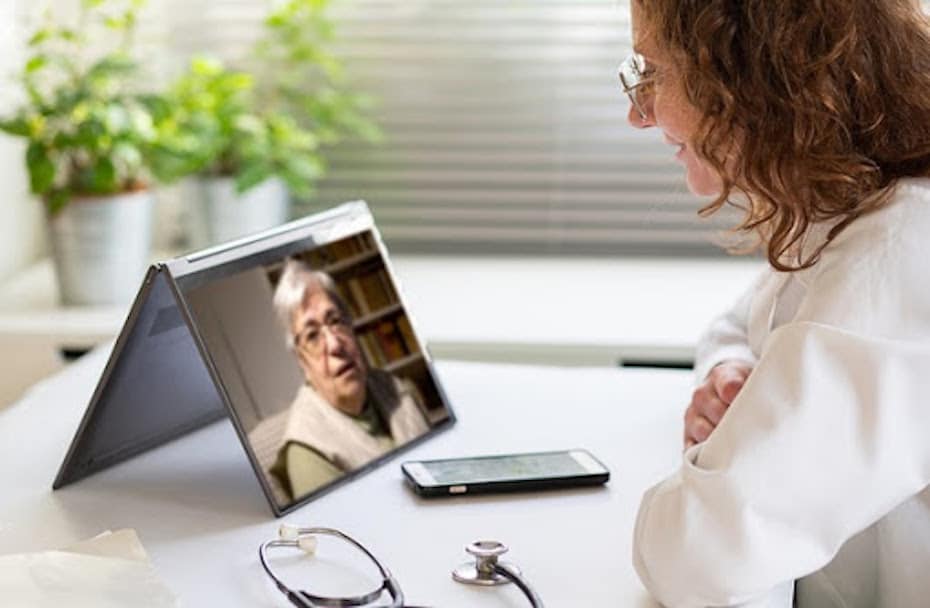Over the past year, there’s been a dramatic rise in telehealth services due to an unprecedented global health crisis. Eventually, the global health crisis will come to an end, and life will return to a modified version of normal. Yet, healthcare providers shouldn’t expect the demand for telehealth services to subside. Patients love the convenience and ease of not having to travel to their doctors for appointments.
Here’s a look at what the hybrid telehealth model means for healthcare organizations, and what they can do to prepare for a hybrid telehealth future. (For providers interested in delivering telehealth, RingCentral Office is currently free.)
Why telehealth is here to stay
Healthcare providers can’t dismiss telehealth as a fad or something they only had to deliver due to a public healthcare crisis. Even at the very beginning of 2020, patient adoption of telehealth was up 33% from 2019. Furthermore, telehealth companies saw a funding boom of $788 million in the first quarter of 2020—something experts say was completely unrelated to the public health crisis. To offer some perspective, telehealth companies raised $220 million in the first quarter of 2019.
Patients began to show a heightened interest in telehealth before 2020 because:
- They don’t have to travel to a doctor’s appointment
- They don’t have to sit in a waiting room
- They can see the doctor in the comfort of their own home
These considerations have a significant impact on patients. A 2017 survey showed that the average in-office visit is 121 minutes long, with 101 of those minutes spent commuting and in the waiting room. If they could avoid that during “normal” times, why wouldn’t they?
Hybrid telehealth: a new model
Thanks to technological developments, as well as an increased desire on the part of patients for telehealth services, a new model is emerging: hybrid telehealth. “Hybrid telehealth” means that healthcare providers offer in-person services as well as telehealth.
Because hybrid telehealth is a new concept, it won’t look the same at every healthcare provider’s office. Some healthcare providers might have a higher percentage of telehealth patients than in-office patients because some disciplines lend themselves more easily to telehealth delivery.
What does hybrid telehealth mean for healthcare providers?
It would make sense that healthcare providers would be prepared to deliver hybrid telehealth services. After all, they’ve become accustomed to, and more adept at, delivering telehealth services during 2020. However, just because an organization has to do something as a result of dire circumstances doesn’t mean that they’ll continue doing that when those circumstances change.
What does hybrid telehealth mean for healthcare providers, then? The following statistics paint a picture of what patients want in the New Normal:
- JD Power’s second annual telehealth satisfaction survey in October 2020 scored patients’ approval of telehealth services at 860 on a 1,000-point scale.
- A study published in July 2020 from the American Gastroenterological Association showed that over 90% of all GI patients said their provider addressed all of their issues during their telehealth visits, and 84% of GI patients were willing to have more telehealth visits in the future.
- Research published by consulting firm Press Ganey in May 2020 showed that over 70% of patients found it was easy to talk to their doctors during a video appointment.

From these reports, it’s clear to see that patients don’t want providers to stop delivering telehealth services even when it’s safe to hold in-person visits. That means that healthcare providers will need to prepare for a future in which they deliver hybrid telehealth services.
Preparing to deliver hybrid telehealth services: what must providers do?
To prepare to deliver hybrid telehealth services, providers must take the following steps:
- Determine which mix of telehealth services and in-person services is right for them
- Promote hybrid telehealth services
- Use the right healthcare communications platform
Determine which mix of hybrid telehealth services works for your practice
No two practices are going to have the same mix of hybrid telehealth services. A psychologist might find that most patients want to hold telehealth visits, while a primary care physician may discover that a large portion of patients may want to be seen in the office.
Take a survey of your patients to understand what mix of hybrid telehealth services would work best. By understanding what patients want and need, you’ll be best able to satisfy them.
Promote your hybrid telehealth services
To borrow a famous movie quote, “If you build it, they will come.” Patients won’t know that you’re offering hybrid telehealth services after the public health emergency ends unless you tell them.
Promoting hybrid telehealth services could include:
- Emailing patients
- Posting on social media
- Calling current telehealth patients and reassuring them they can continue with virtual appointments
An Accenture report from July 2020 shows that 60% of patients want to continue using telehealth services to communicate with providers and manage their conditions going forward. By letting your patients know that you offer this service, they won’t go searching for another provider that does deliver hybrid telehealth.
Use the right telehealth communications platform
The final key to hybrid telehealth success is using the right telehealth communications platform. What does the right telehealth communications platform look like?
- It allows for telephony, chats, and videoconferencing.
- You can set up a patient access center, so patients can reach you and your colleagues outside of appointments for quick questions.
- You can extend your reach beyond your physical practice—patients from underserved areas can take advantage of hybrid telehealth services.
- You can easily scale the telehealth communications platform so that specialists can use it as well, and you can reach more patients.
- It’s highly secure, so patient data is never compromised.
Deliver hybrid telehealth services with RingCentral
RingCentral’s healthcare communications platform gives healthcare providers the flexibility they need to deliver hybrid telehealth services into the future, so they can boost patient satisfaction. See how cloud communications can transform your healthcare organization. Request a demo.
Originally published Dec 08, 2020, updated Jul 25, 2024





